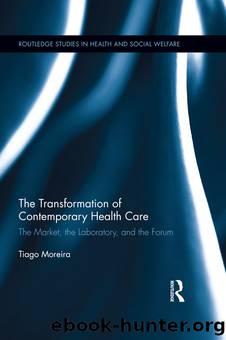The Transformation of Contemporary Health Care by Moreira Tiago;

Author:Moreira, Tiago; [Tiago Moreira]
Language: eng
Format: epub
ISBN: 1181006
Publisher: Taylor & Francis Group
PUTTING HEALTH CARE IN THE LABORATORY?
The mobilisation of the ideal of the laboratory and of the practices associated with it to articulate the role and function of modern medicine has been a consistent focus of attention for historians and sociologists of medicine. In this, laboratory medicine appears as a historically contextualised form of knowledge production and use in health care. In a seminal paper, Jewson (1976) proposed a chronological typology of medicine. The first model is that of neo-classical âbedside medicineâ, in which doctors produced a biographical form of knowledge of their clients, based on relations of patronage. This person-centred medicine was replaced progressively by hospital medicine in close articulation with the rise of a bureaucratic state in Europe and North America. Doctors increasingly sought prestige amongst peers rather than patrons, and knowledge became reliant on the understanding of disease based on pathological anatomy rather than the âsick-manâ. The third stage in Jewsonâs model is laboratory medicine, which he defined as characterised by knowledge of physiological processes at the cellular level, a stage closely related to the establishment of the German university system in the mid-19th century. It was an academic rather than professional form of knowledge which mobilised the laboratory to discipline doctorsâ practices.
Pickstone (2000), drawing on Foucaultâs (1973) analysis of the clinic and historical work on the development of laboratory practices in medicine, argued that where Jewson saw a continuum between hospital medicine and laboratory medicine, it was possible to identify a significant shift in epistemic cultures between these types of medicine. While hospital medicine was based on the analytical work of collecting and classifying pathological specimens, experimental medicine emphasised control and novelty, driven by academic forms of reward and supported by instrumental measurement, standardisation of procedures, tools and representation of results. Laboratory medicine was both a practice and a discourse that invested the laboratory with the capacity not only to regulate professional practice but also promised, through this reform of medical practice, to systematically eradicate illness and disease from society. For example, in a study of the introduction of blood pressureâmeasuring instruments in medicine in the US, Evans (1993) describes how âphysiologically mindedâ doctors, promoting the standardisation of patient data in hospitals, invested in those instruments the capacity to constantly remind doctors of the physiological principles that lie behind a blood pressure measurement. Pickstone further identifies another mode of medicine, labelled techno-medicine, in which knowledge is produced through collaborations between universities, hospitals, pharmaceutical companies and the state or philanthropic organisations such as the Rockefeller Foundation. These collaborations were oriented towards the production of diagnostic devices or therapeutic agents and became steadily established during the 20th century in Europe and North America.
Interestingly, in his analysis of the emergence of methods of regulation of therapeutics, Marks (1997; 2000) sees this new economic and epistemic configuration as the context for the mobilisation of the ideal of the laboratory in attempts to control the influence of âcommerceâ and the market in medicine, particularly in the US. However, to understand why experimental
Download
This site does not store any files on its server. We only index and link to content provided by other sites. Please contact the content providers to delete copyright contents if any and email us, we'll remove relevant links or contents immediately.
Application of a Novel Technique for Clinical Evaluation of Nitric Oxide-Induced Free Radical Reactions in ICU Patients by Unknown(696)
Rosenâs Emergency Medicine Concepts and Clinical Practice by Ron Walls; Robert Hockberger; Marianne Gausche-Hill; Timothy B. Erickson; Susan R. Wilcox(572)
Oxidative damage to surfactant protein D in pulmonary diseases by Vitality Starosta1 & Matthias Griese1†(408)
Social Science Perspectives on Global Public Health by Vincent La Placa & Julia Morgan(375)
Constructing Canine Consent; Conceptualising and Adopting a Consent-focused Relationship with Dogs by ERIN JONES(330)
Organic Chemistry: An Acid - Base Approach by MICHAEL SMITH(300)
ADVANCED EMERGENCY CARE AND TRANSPORTATION OF THE SICK AND INJURED by Unknown(271)
Saunders Nursing Drug Handbook 2024 - E-Book by Unknown(263)
Davis's Comprehensive Manual of Laboratory and Diagnostic Tests with Nursing Implications by Unknown(249)
Socio-Life Science and the COVID-19 Outbreak : Public Health and Public Policy by Makoto Yano; Fumihiko Matsuda; Anavaj Sakuntabhai; Shigeru Hirota(247)
Diagnostic and Statistical Manual of Mental Disorders, Fifth Edition, Text Revision (DSM-5-TR(tm)) by Unknown(246)
Human Microanatomy; Cell Tissue and Organ Histology with Celebrity Medical Histories by Stephen A. Stricker(245)
Berne and Levy Physiology E-Book by Unknown(236)
Replacing the Dead by Mie Nakachi;(231)
Handbook of Skin Disease Management by Jiyad Zainab;Flohr Carsten; & Carsten Flohr(229)
Access to Medicines and Vaccines in the South : Coherence of Rules and Policies Applied by the European Union Commission by Stephen Kingah(226)
Deep Learning and Medical Applications by Unknown(222)
The Pocket Guide to Sensorimotor Psychotherapy in Context (Norton Series on Interpersonal Neurobiology) by Pat Ogden(218)
Advances and Technical Standards in Neurosurgery by Unknown(215)
